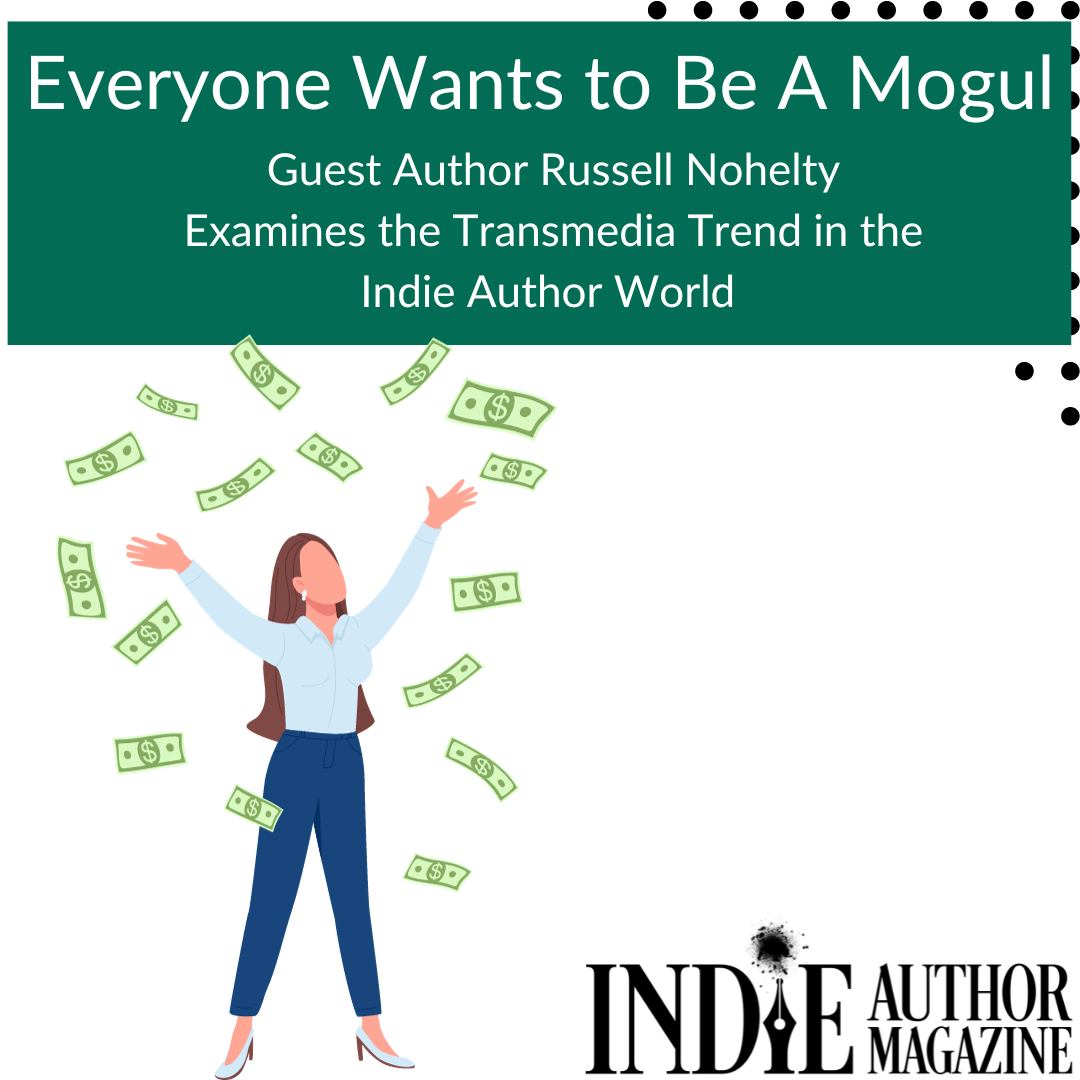Guest Author Russell Nohelty Examines the Transmedia Trend in the Indie Author World
There’s genre hopping, and then there’s medium hopping.
Depending on how you look at his career, Russell Nohelty has done both. As a USA Today bestselling author and the co-founder of Writer MBA and the Author Ecosystem archetypes, Nohelty has put his name on graphic novels, Fantasy novels, nonfiction author guides, and more. At the same time, he’s created card games and comics, collaborated with a coffee brand, and explored a range of other areas seemingly far outside of the literary world. It’s all in an effort to capitalize on the growing trend of utilizing transmedia—expanding a story across multiple mediums to draw in new audiences.
Transmedia is not an adaptation of a story; instead, it’s the use of various mediums to explore new aspects of an existing story world. It’s also part of the future of the indie author industry, Nohelty says. This month, Nohelty is sharing his thoughts on the concept, the benefits and challenges it can pose for authors, and—most importantly—how authors can use transmedia to grow their readership and their business.
Living in Los Angeles, some of the most common questions I get revolve around how to turn a book into a movie, video game, or generally how to translate an author’s work into another medium.
Transmedia is definitely a buzzword, but it doesn’t mean what you think it means. It’s not about translating your existing work into a new format verbatim. It’s much cooler—and more complicated.
From a production standpoint, transmedia storytelling involves creating content that engages an audience using various techniques to permeate their daily lives. To achieve this engagement, a transmedia production will develop stories across multiple forms of media in order to deliver unique pieces of content on each channel. Importantly, these pieces of content are not only linked, overtly or subtly, but they are also in narrative synchronization with one another.
My current understanding of transmedia is that it involves telling a cohesive story across mediums. And one of my favorite examples is Matrix: Reloaded.
I love Matrix: Reloaded, despite all the hate it receives, but I will admit that a lot of my love for that movie comes from the Enter the Matrix video game. You learn so much more about the world of the movie by playing the game.
Another example is The Lizzie Bennet Diaries, wherein the YouTube series was augmented by Twitter feeds and other media that fleshed out the world.
The goal of a transmedia project is to find new audiences for your work by expanding formats to capture new fans across modalities. In authorship, this is expressed perfectly by the LitRPG genre. Authors combined role-playing games and novels into one story to bring in fans from each and create something wholly new.
Of course, LitRPGs are not transmedia; they are multimodal. If you talk to a LitRPG author for any length of time, they will start talking about modalities, which are the specific ways that something is experienced or expressed. So why am I confusing you by talking about LitRPG when it’s not even an example of transmedia? Because thinking in modalities is a key feature of having success in transmedia.
With transmedia, the author’s job is to express ideas in new and exciting ways that will drive new readers to your books. To have success with transmedia, you need to stop thinking about your books as the end product and pull back to focus on your brand as a whole.
If you’re interested in transmedia, here are four options with a relatively low barrier to entry:
- Choose-your-own-adventure blog: It’s relatively cheap, though time-consuming, to set up a blog with a branching decision tree set in your universe.
- Augmented reality social media profiles: If you have a contemporary story, you can set up social media profiles that flush out your world.
- One-page RPG adventure: While creating an entire RPG is time-consuming and expensive, building a one-page RPG that can be consumed easily is manageable with limited resources.
- A website for a business in your world: With all the website builders on the market today, it’s relatively simple and cheap to set up a website that helps draw people into your work.
There are countless more simple and effective ways to draw readers deeper into your brand. However, each will still have a financial and mental cost. This is why most authors working in transmedia rely heavily on partnerships to succeed. If an author can find a partner and trust them to carry out their vision, then they can grow exponentially.
Attracting partners usually takes a successful series with significant success behind it. Look at George Lucas. He had the most popular movies in the world with the Star Wars series, which allowed him to release merchandising and create other media quickly to feed his fandom.
For years, the brand only had three movies. But if movies were the primary modality by which people found his work, people funneled to and from the movies into toy lines, video games, television shows, books, comics, and more. Lucas primarily grew his brand by expressing his vision through modalities outside of movies, and through characters in his universe who weren’t in the core cast.
This is the ideal way to think about having success in transmedia. The question is really, “How can I bring new fans of my work by engaging with them in a new way?”
Earlier this year, I worked with a company to release a card game for one of my brands, and I’m working with different companies to create other experiences that allow my existing fans to express their excitement in new ways while bringing new fans into my universe. Whatever you choose to do, the goal is to meet fans where they are and introduce them to your universe in new and interesting ways.
On top of that, you give your existing fans more ways to fall deeper in love with your brand.
Just a quick note of warning: once you start “feeding the beast” and expanding your brand, fans in those new modalities will expect you to continue servicing their needs, which can be expensive. Additionally, while you likely know how to grow your readership, every time you enter a new market, you are effectively starting from scratch. Yes, you might have fans willing to join you in other modalities, but you might not.
Reaching out to brand partners can be scary, but brands, especially newer ones, are looking for established brands they can partner with in order to grow their own audiences. There are likely already new and emerging companies in the modalities you are looking to explore that would be interested in working with you, if you have sales and an audience to back up your enthusiasm.
This is one reason doubling down on learning sales and marketing is so important. Once you have sales behind your series, brand partners will come out of the woodwork to work with you.
Last year we had a coffee brand reach out to us to launch a Cthulhu is Hard to Spell decaf coffee, and it was great. If you don’t have the sales to justify expansion yet, the best thing you can do is learn how to sell your books so that you have an audience that attracts brands to you while also giving you an audience to serve.
None of these modalities will likely be a silver bullet to make you a fortune alone, but bring them together, and you can create a compelling universe that fans want to live in for years to come.

